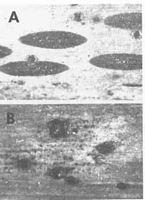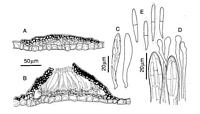|
 Hypohelion parvum Hypohelion parvum
BiostatusPresent in region - Indigenous. Endemic
Images (click to enlarge)
Caption: Fig. 1. Macroscopic appearance of ascomata (x15). A, Hypohelion scirpinum (Rehm, Asc. No. 1953 - NY).
B, H. parvum (PDD 48879). | 
Caption: Fig 4. Hypohelion parvum. A, Unopened ascoma in vertical section. B, Opened ascoma in
vertical section. C, Asci. D, Apex of asci and paraphyses. E, Released ascospores. (A-E,
PDD 48879). |
Article: Johnston, P.R. (1990). Hypohelion gen. nov. (Rhytismataceae). Mycotaxon 39: 219-227.
Description: Ascomata developing on dead leaves, not associated with paler areas on leaf, but sometimes
with individual ascomata surrounded by narrow, black zone lines. Not associated with
conidiomata. In surface view ascomata 0.4-0.7 x 0.2-0.3 mm, more or less elliptic or irregular
in outline. Unopened ascomata with uniformly black walls. Ascomata opening by an irregular
split either elongate or radiate, depending on ascomatal shape. No differentiated zone visible
along edge of opening split.
Ascomata subcuticular. In vertical section upper wall of unopened ascomata up to 20 µm
thick, comprising brown to dark brown, thick-walled, angular cells. In opened ascomata
upper wall 15-20 µm thick, becoming gradually narrower toward outer edge, comprising dark
brown, thick-walled, angular cells. No differentiated layer associated with edge of the
ascomatal opening. Darkened lower wall absent.
Paraphyses 1.5-2 µm diam., swelling up to 5 µm diam. at the clavate apex, extending 5-10
µm beyond asci. Asci 65-90 x 9-10 µm, clavate, tapering gradually to rounded apex, wall
undifferentiated at apex, 8 spored, spores extending almost to base, maturation sequential.
Ascospores 23-32 x 3-3.5 µm apex rounded, tapering to more or less acute base, 1 septate,
surrounded by narrow gelatinous sheath.
Habitat: Dead leaves of Carex.
Distribution: New Zealand: Westland.
Notes: Etymology: parvum = small; refers to small size of ascomata, asci and ascospores compared
to H. scirpinum, the type species of the genus.
|